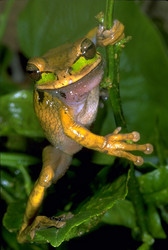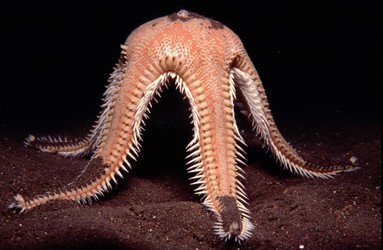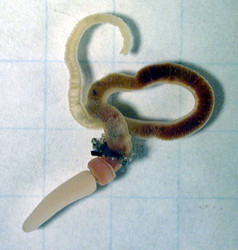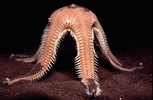Deuterostomia



This tree diagram shows the relationships between several groups of organisms.
The root of the current tree connects the organisms featured in this tree to their containing group and the rest of the Tree of Life. The basal branching point in the tree represents the ancestor of the other groups in the tree. This ancestor diversified over time into several descendent subgroups, which are represented as internal nodes and terminal taxa to the right.

You can click on the root to travel down the Tree of Life all the way to the root of all Life, and you can click on the names of descendent subgroups to travel up the Tree of Life all the way to individual species.
For more information on ToL tree formatting, please see Interpreting the Tree or Classification. To learn more about phylogenetic trees, please visit our Phylogenetic Biology pages.
close boxReferences
Jaime E. Blair, J. E. and S. B. Hedges. 2005. Molecular phylogeny and divergence times of deuterostome animals. Molecular Biology and Evolution 22:2275-2284.
Bromham, L. D. and B. M. Degnan. 1999. Hemichordates and deuterostome evolution: robust molecular phylogenetic support for a hemichordate plus echinoderm clade. Evolution and Development 1:166-171.
Bourlat, S., C. Nielsen, A. Lockyer, D. T. Littlewood, and M. Telford. 2003. Xenoturbella is a deuterostome that eats molluscs. Nature 424:925-928.
Cameron, C.B., J. R. Garey, and B. J. Swalla. 2000. Evolution of the chordate body plan: New insights from phylogenetic analyses of deuterostome phyla. Proceedings of the National Academy of Sciences USA 97:4469-4474.
Castresana, J., G. Feldmaier-Fuchs, S. Yokobori, N. Satoh, and S. P?abo. 1998. The mitochondrial genome of the hemichordate Balanoglossus carnosus and the evolution of deuterostome mitochondria. Genetics 150:1115-1123.
Chea, H. K., C. V. Wright, and B. J. Swalla. 2005. Nodal signaling and the evolution of deuterostome gastrulation. Developmental Dynamics 234:269-278.
Dominguez, P., A. G. Jacobson, and R. P. S. Jefferies. 2002. Paired gill slits in a fossil with a calcite skeleton. Nature 417:841-844.
Halanych, K. M. 1995. The phylogenetic position of the pterobranch hemichordates based on 18S rDNA sequence data. Molecular Phylogenetics and Evolution 4:72-76.
Henry, J. Q., K. Tagawa and M. Q. Martindale. 2001. Deuterostome evolution: early development in the enteropneust hemichordate, Ptychodera flava. Evolution and Development3:375-390.
Jefferies, R. P. S. , N. A. Brown, and P. E. J. Daley. 1996. The early phylogeny of chordates and echinoderms and the origin of chordate left-right asymmetry and bilateral symmetry. Acta Zoologica 77:101-122.
Lacalli, T. C. 2002. Vetulicolians - are they deuterostomes? chordates? BioEssays 24:208-211.
Mallatt, J. and C. J. Winchell. 2007. Ribosomal RNA genes and deuterostome phylogeny revisited: More cyclostomes, elasmobranchs, reptiles, and a brittle star. Molecular Phylogenetics and Evolution 43(3):1005-1022.
Ruta, M. 1999. Brief review of the stylophoran debate. Evolution and Development 1:123-135.
Shu, D. G., S. Conway Morris, J. Han, L. Chen, X. L. Zhang, Z. F. Zhang, H. Q. Liu, Y. Li, and J. N. Liu. 2001. Primitive deuterostomes from the Chengjiang Lagerstatte (Lower Cambrian, China). Nature 414:419-424.
Swalla, B. J., C. B. Cameron, L. S. Corley, and J. R. Garey. 2000. Urochordates are monophyletic within the deuterostomes. Systematic Biology 49:52-64.
Turbeville, J. M., J. R. Schulz and R. A. Raff. 1994. Deuterostome phylogeny and the sister group of the chordates: evidence from molecules and morphology. Molecular Biology and Evolution 11:648-655.
Wada, H. and N. Satoh. 1994. Details of the Evolutionary History from Invertebrates to Vertebrates, as Deduced from the Sequences of 18S rDNA. Proceedings of the National Academy of Sciences USA 91:1801-1804.
Winchell, C. J., J. Sullivan, C. B. Cameron, B. J. Swalla, and J. Mallatt. 2002. Evaluating hypotheses of deuterostome phylogeny and chordate evolution with new LSU and SSU ribosomal DNA data. Molecular Biology and Evolution 19:762-776.
Title Illustrations

| Scientific Name | Smilisca phaeota |
|---|---|
| Location | Costa Rica, cloud forest on Caribbean slope |
| Specimen Condition | Live Specimen |
| Copyright |
© Greg and Marybeth Dimijian

|
| Scientific Name | Astropecten aranciacus |
|---|---|
| Location | Madeira Island |
| Specimen Condition | Live Specimen |
| Identified By | id confirmed by Christopher Mah (from photograph) |
| Behavior | presumed spawning position |
| Copyright |
© Peter Wirtz

|
| Scientific Name | Saccoglossus kowalevskii |
|---|---|
| Creator | David Remsen |
| Copyright |
© 1995 Marine Biological Laboratory, Woods Hole

|
About This Page
Page copyright © 2002
All Rights Reserved.
Citing this page:
Tree of Life Web Project. 2002. Deuterostomia. Version 01 January 2002 (temporary). http://tolweb.org/Deuterostomia/2466/2002.01.01 in The Tree of Life Web Project, http://tolweb.org/











 Go to quick links
Go to quick search
Go to navigation for this section of the ToL site
Go to detailed links for the ToL site
Go to quick links
Go to quick search
Go to navigation for this section of the ToL site
Go to detailed links for the ToL site